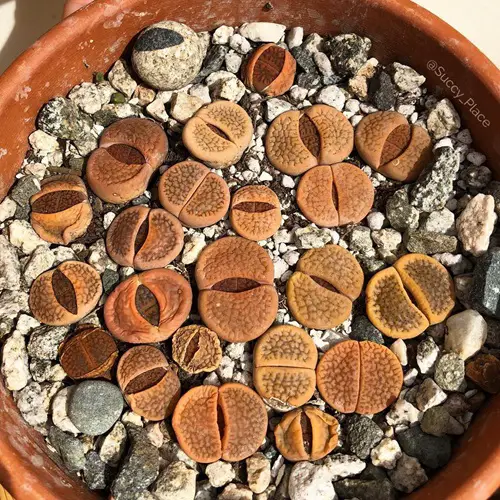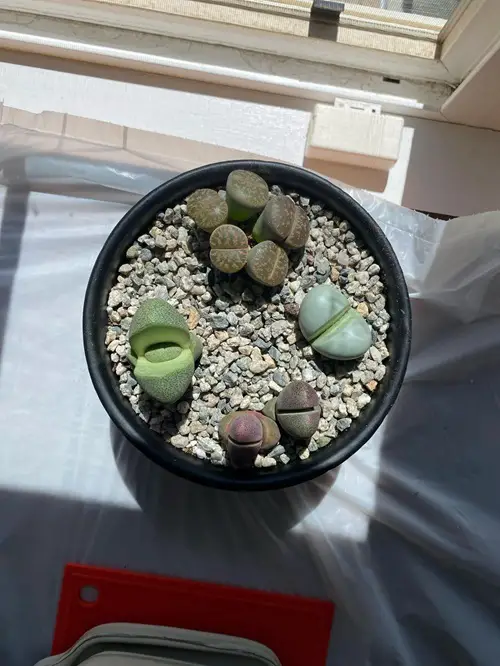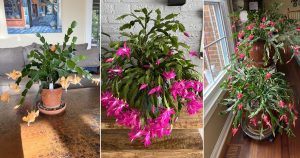Let’s figure out why your Lithops are shrinking in winter and learn what to do about it. Don’t miss out on the secret tips and tricks!
There can be quite a few reasons why your Lithops are shrinking in winter, either they are wilting away to produce new growth or they might be starving for water. While these tiny living pebbles are quite easy to care for, they can sometimes shrivel up and look unhealthy. Don’t worry—by the end of this guide, you’ll have all the tools to bring your Lithops back to life!
Lithops or Living Stones
Lithops are tiny succulents that generally hail from western and central areas of southern Africa. William John Burchell in 1811 discovered the first ever Lithops during a botanical expedition in southern Africa. During his travels, he found a strange-looking brownstone with a fissure across the surface that turned out to be a succulent plant.
In their native habitats in Namibia and South Africa, Lithops have well adapted to their surroundings. They appear like sand and stones in shape, size, and color that can be quite difficult to spot. Additionally, they are also drought-tolerant because of their ability to store water in their two thick succulent leaves that are fused in an inverted cone shape. The fissure at the top is the division between the leaves.
Why Your Lithops Are Shrinking in Winter?
If the leaves start to wrinkle and shrink, it’s a sign that your plant needs water or that they are undergoing a dormant phase in winter and shrinking their old leaves to give out new growth.
Lithops that look plump or swollen indicate that they are healthy and hydrated. But here’s the tricky part—these little succulents play the long game. You should only water them when the old leaves look significantly shriveled, not just slightly wrinkly. It’s all about patience! Small lines or wrinkles may appear which indicate that the plant is losing water and is starting to shrink.
Winter Care Requirements for Lithops
1. Stick To A Good Watering Routine
In winter, during their dormant phase, withhold watering as much as possible to promote the shriveling of the old leaves and the formation of new ones. By early spring the new body will be visible. If water is given too soon, the old “leaves” will continue to grow and the plant will not develop properly. Remember, the old leaves should dry up as the new leaves are growing.
One golden rule to remember—When in doubt, don’t water! Lithops are better off slightly thirsty than drowning. Overwatering can turn your prized succulents into mush faster than you can say “living stones.”
Watering these Living pebbles is quite a task when it comes to maintenance. The right time and soil conditions are what you need to consider to pick up the skill of watering them. Too much water can lead to rot, while too little will stunt their growth.
2. A Cozy Bright Spot
Lithops appreciates bright places to stay healthy so in the cooler months, you can add beauty to your empty windowsill by placing them there. They will need at least 4-5 hours of direct sunlight in the early part of the day and some partial shade in the afternoon.
If you’re growing Lithops indoors and don’t get enough sunlight, consider using a grow light. It’s like giving them their own little sun to bask under!
If your plant doesn’t receive enough sunlight it will start to grow weak and slender with thin, elongated growth that leans to one side. It will also lose the bright, happy colors and patterns, gradually turning green to die eventually!
Tip: A south-facing window is the best spot for enjoying a bright day throughout. But if you notice your Lithops stretching toward the light, it’s a sure sign they need a little more sun.
3. Look Out For the Temperature
During winter, you must bring them indoors to protect them from the frost because they do not tolerate freezing temperatures. You see, Lithops are desert succulents, they have that in-built ability to tolerate harsh arid conditions so, frost or extreme cold is something they do not enjoy much!
The suitable temperature ranges from 65°F to 80°F (18°C to 26°C) for healthy growth in Lithops. When indoors, they are safe from frosty winds, snow, and sudden temperature fluctuations. Also, the use of radiators and heaters inside helps keep the temperature within this range.
Here’s a quick note—While heaters keep your home warm, placing Lithops too close to them can dry the air out quickly. Just try using a humidity tray or keeping them slightly away from direct heat sources to maintain a balance.
However, when you keep your plants inside to give them winter protection, always keep one thing in mind—don’t place them too close to drafty windows and doors. The frequent shutting and opening causes a definite temperature fluctuation that affects them, causing sudden damage.
So, now you know the answer and have the solution! Let’s get to work and save these cute succulents. Although, if you are still in any kind of doubt then feel free to catch up with us anytime.












